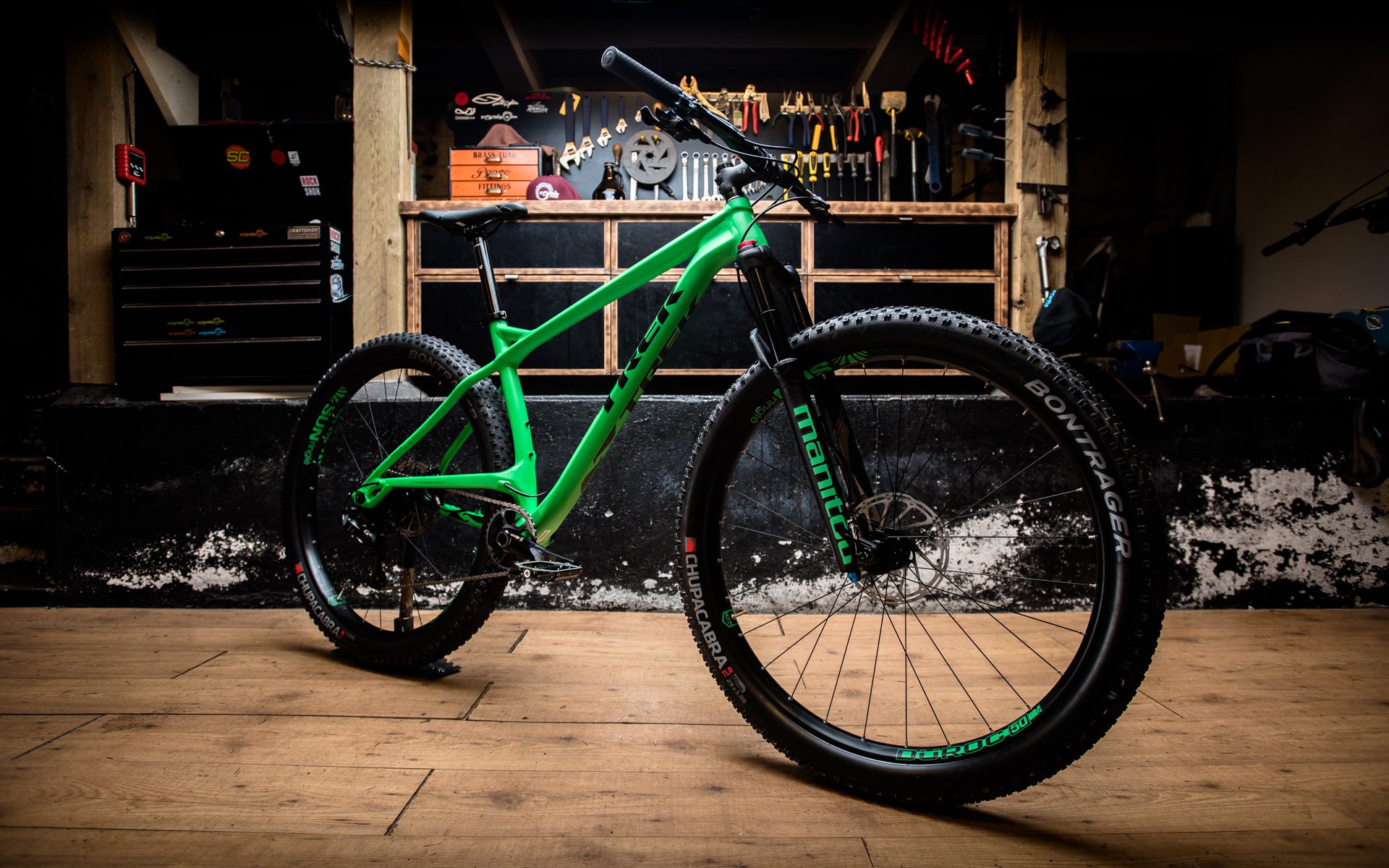
First Impressions
2017 TREK STACHE 29+ Hardtail
Build It
Unpacking the aluminum Stache 7 I can't help but chuckle at how much frame manipulation is taking place in this 'simple' 29+ hardtail package. I've seen the carbon version in person but that was less unexpected. Companies have been making crazy looking carbon bikes since the Trimble.
There is no shortage of aluminum full suspension bikes with ample aluminum manipulation but aluminum hardtails are usually far more straightforward. From the captured sliding drop-outs*, to the elevated driveside chainstay, to the highly formed seat tube there is a tonne going on.
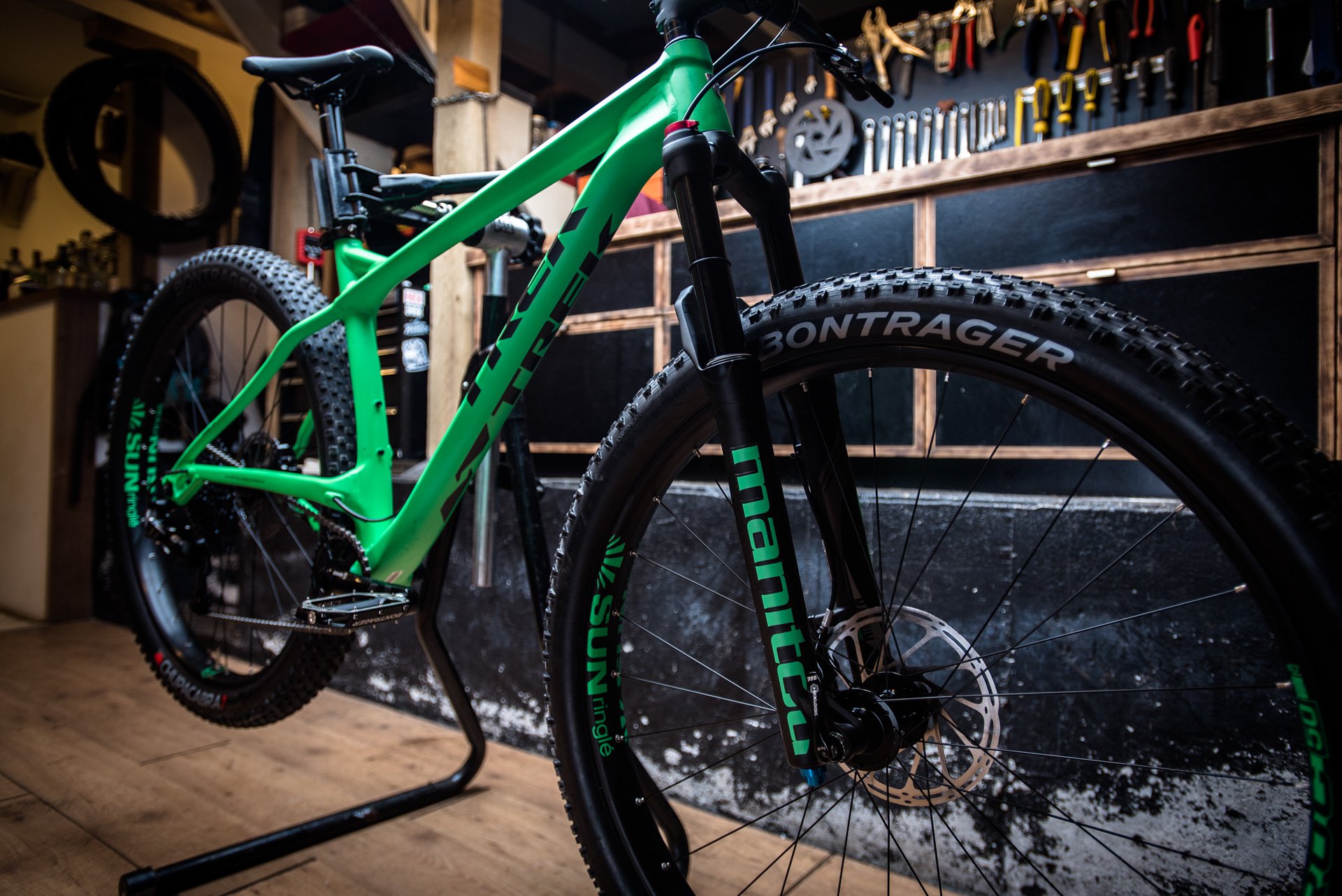
Manipulate this! There is an impressive amount of attention to detail - for a hardtail - present in the aluminum Stache's frameset. While the wheels are indeed huge, the elements balance nicely in person.
But I'm getting ahead of myself. Putting the Stache in my bike stand I notice a separate cardboard box. I guess no one told Trek that no one is including cheap plastic pedals with bikes anymore?
In fact it's a set of 29+ tubes. Yep, the Stache comes stock set-up tubeless and ready to roll with my first two tubes courtesy of Trek. Maybe not a big deal but thoughtful nonetheless. Straight out of the box the bike shifts perfectly and the brakes are expertly aligned. I drop the fork and put a North Shore-suitable amount of grease on the headset bearings, install the front wheel and it's ready to ride.
I've never had a bike go together so well out of the box. Well played Trek.
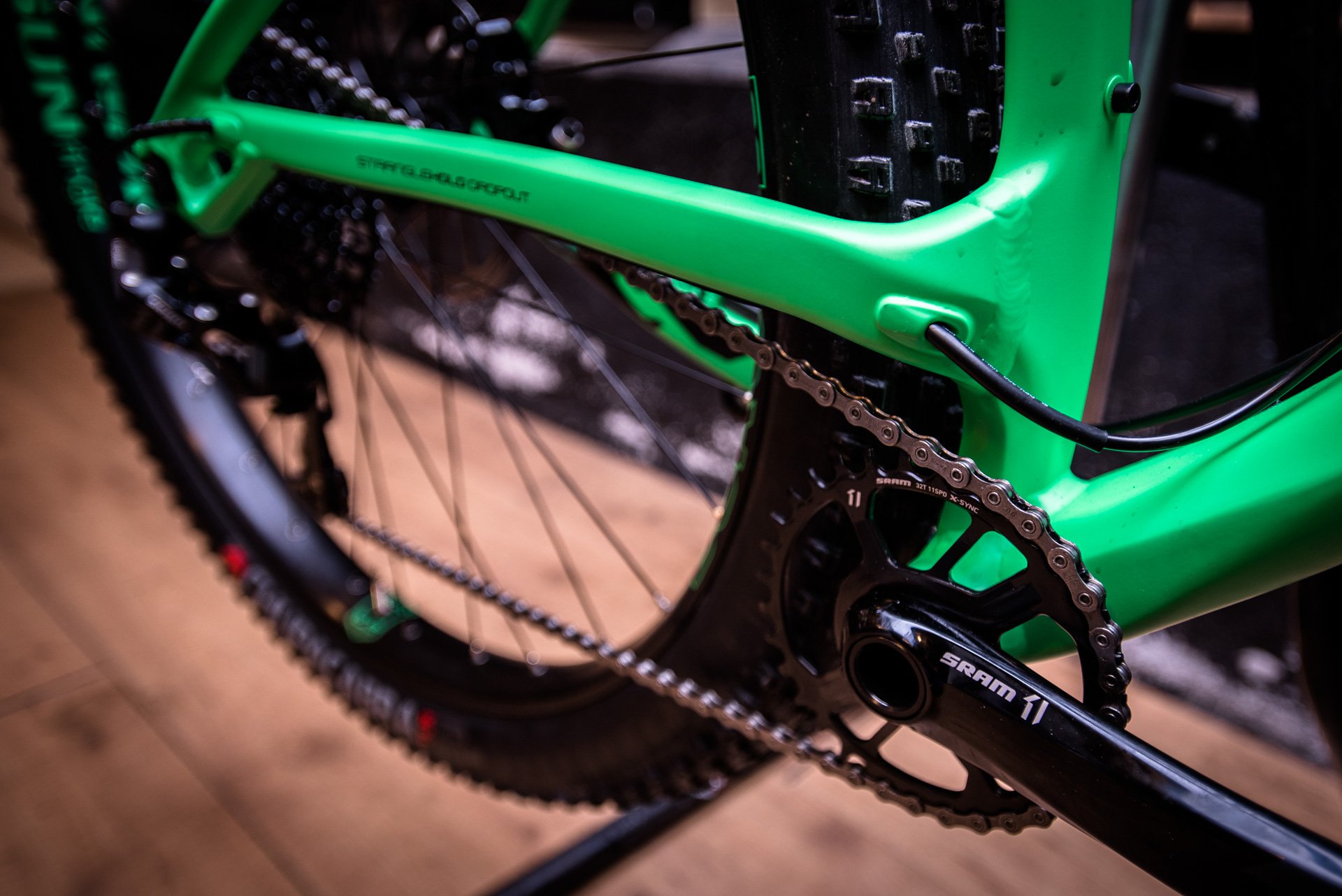
Captured sliding dropouts. Elevated chainstay for tire and drivetrain clearance with short 420mm stays. Internal shifter routing. SRAM GX drivetrain with X1 crankset.Bright Green.
Chupacabra
Apart from the highly manipulated aluminum frame, the heart of the Stache is its Bontrager Chupacabra tires. The tires are highly rated for good traction, light weight, relative durability and fast rolling. Unsurprisingly, as a front on greasy spring Shore trails, the tire quickly busts through its comfort zone with anything but the most diligent braking pressure.
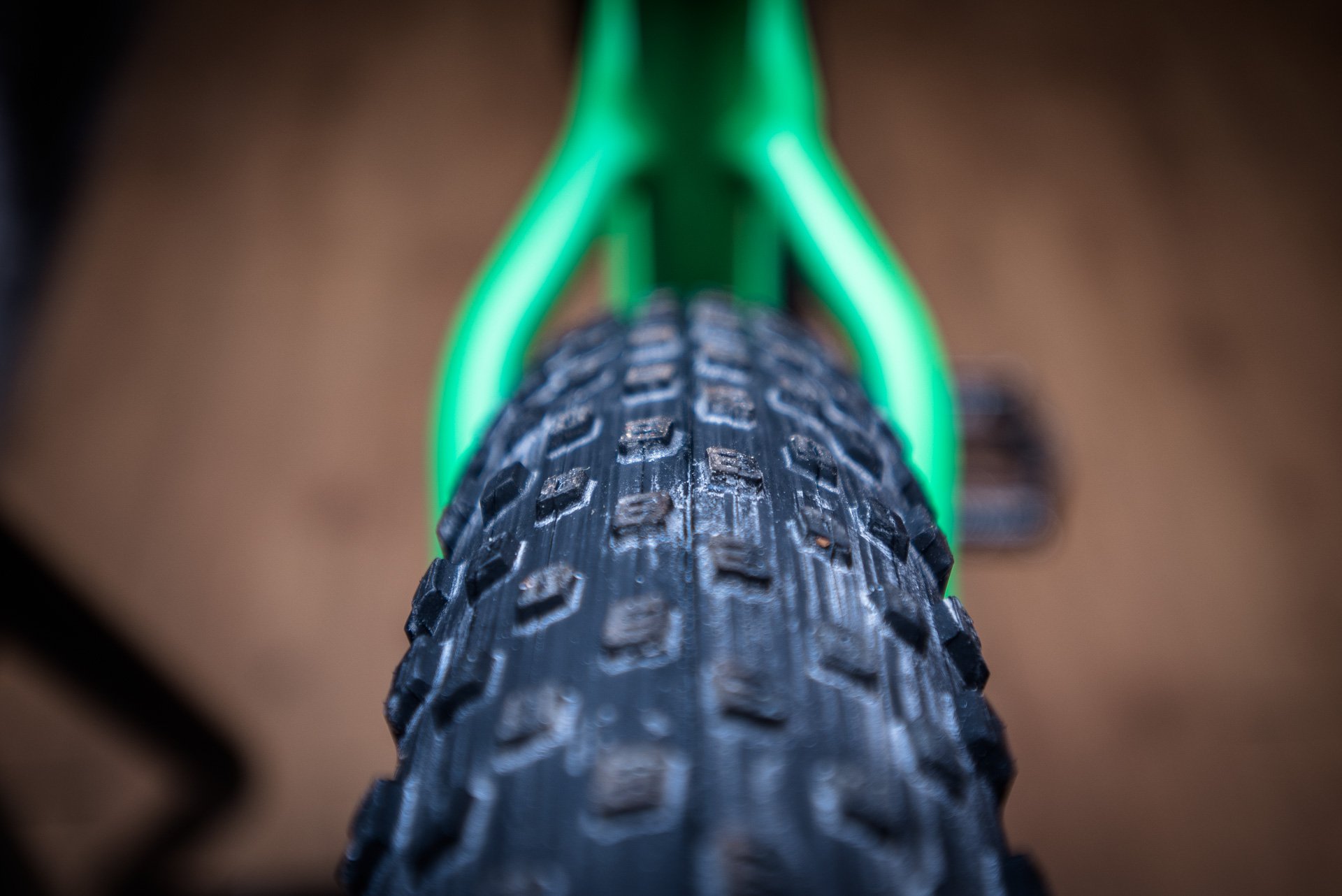
World wide spec decisions. I know from friends in drier, flatter and less rocky locales that the Bontrager Chupacabra provides a great balance of traction, rolling resistance, durability and weight. It's an extra greasy spring here on the Shore and these tires force me to choose between excessively low pressures and razor focus on braking or unplanned acceleration.
With the tires aired down to 14/15psi they offer a surprising level of grip but the light sidewalls make me cringe every time I bottom the rim.
My plan is to ride the stock tires with low air pressure, combined with the Huck Norris system to test the claim that the 85-gram-per-wheel weight of the system can be offset by running lighter tires. Barring that I'll swap the Maxxis 29 x 3" DHF 3c from my personal ride to properly test the bike with the one out-of-the-box upgrade I'd suggest to Stache riders in similarly greasy climes; a mean-ass front tire.
GX Drivetrain
This will be my first longer term experience on a SRAM GX drivetrain which is the most interesting in SRAM's product line. In my previous experience with fresh GX groups, the system was as fast and accurate as the more expensive lines. It takes on weight compared to an X01 or XX1 setup and has less gear range but unless durability is an issue I think it will present the best value in SRAM's lineup.
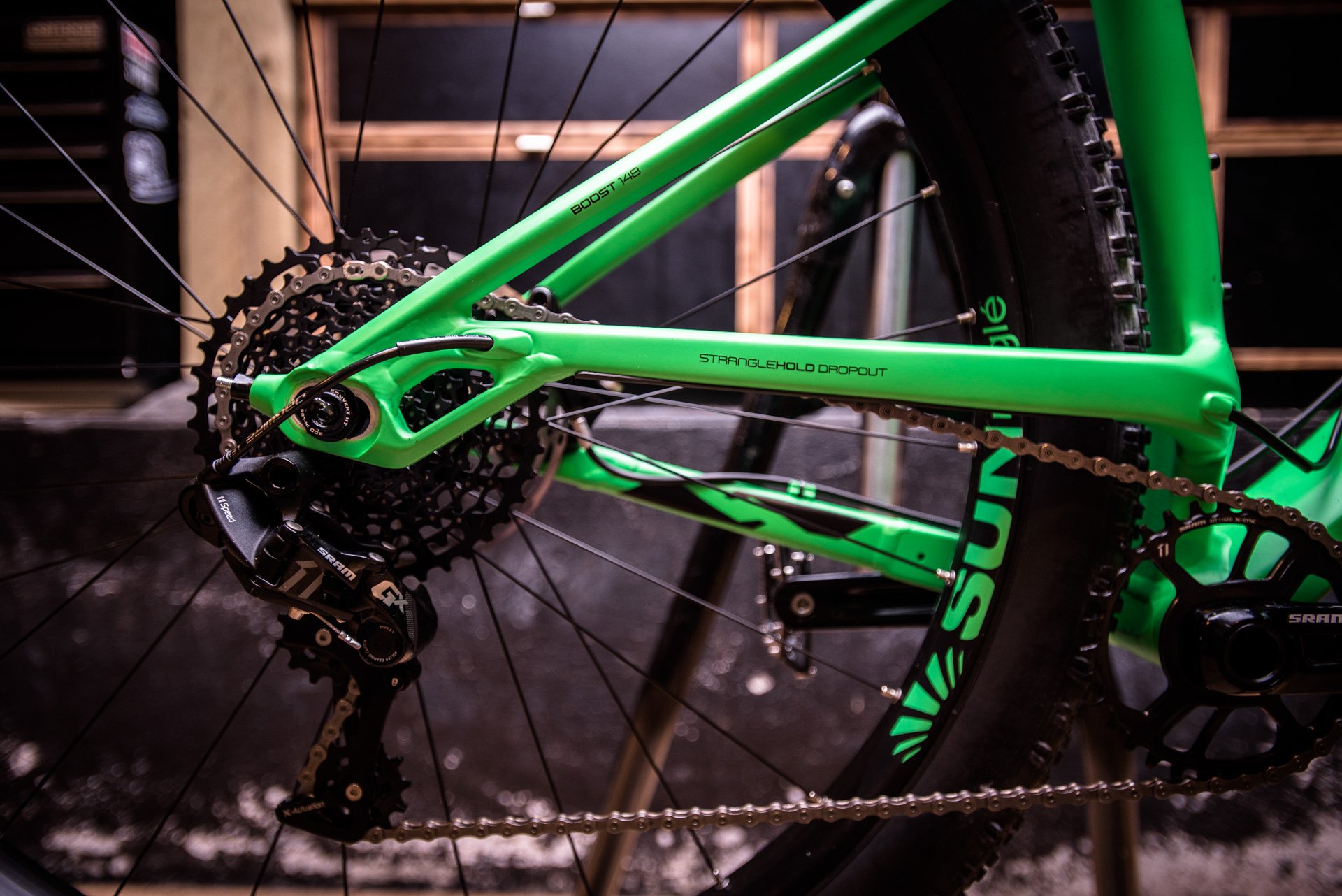
I think SRAM's GX drivetrain is the most interesting in the product line. It gives up nothing on shifting speed, feel, and accuracy compared to their higher end products at a fairly minor weight gain. Comparative durability is the question left unanswered for me.
My only concern was ergonomic. The shifter does not have the adjustable lower paddle of SRAM's more expensive options - and I always seem to be adjusting the paddle when I get on a bike someone else has ridden. My concerns were assuaged on my shake out neighbourhood pedal. Shifting is fast and natural.
Dropper Post
Usually when I'm looking at a mountain bike in the $2100 (USD) | $2700 (CAD) range I feel like companies are doing a disservice to riders by not bumping the price range up a touch and including a dropper post. It is an upgrade that I foresee the average Stache 7 owner adding in short order and something that is included in both of its higher-priced carbon brethren.
That said, in this case I greatly appreciate Trek leaving the dropper post decision up to their customers. The highly manipulated seat tube, curved to achieve the holy grail of shorts stays and tire clearance, restricts the space available for a stealth dropper unless you are the long-legged sort.
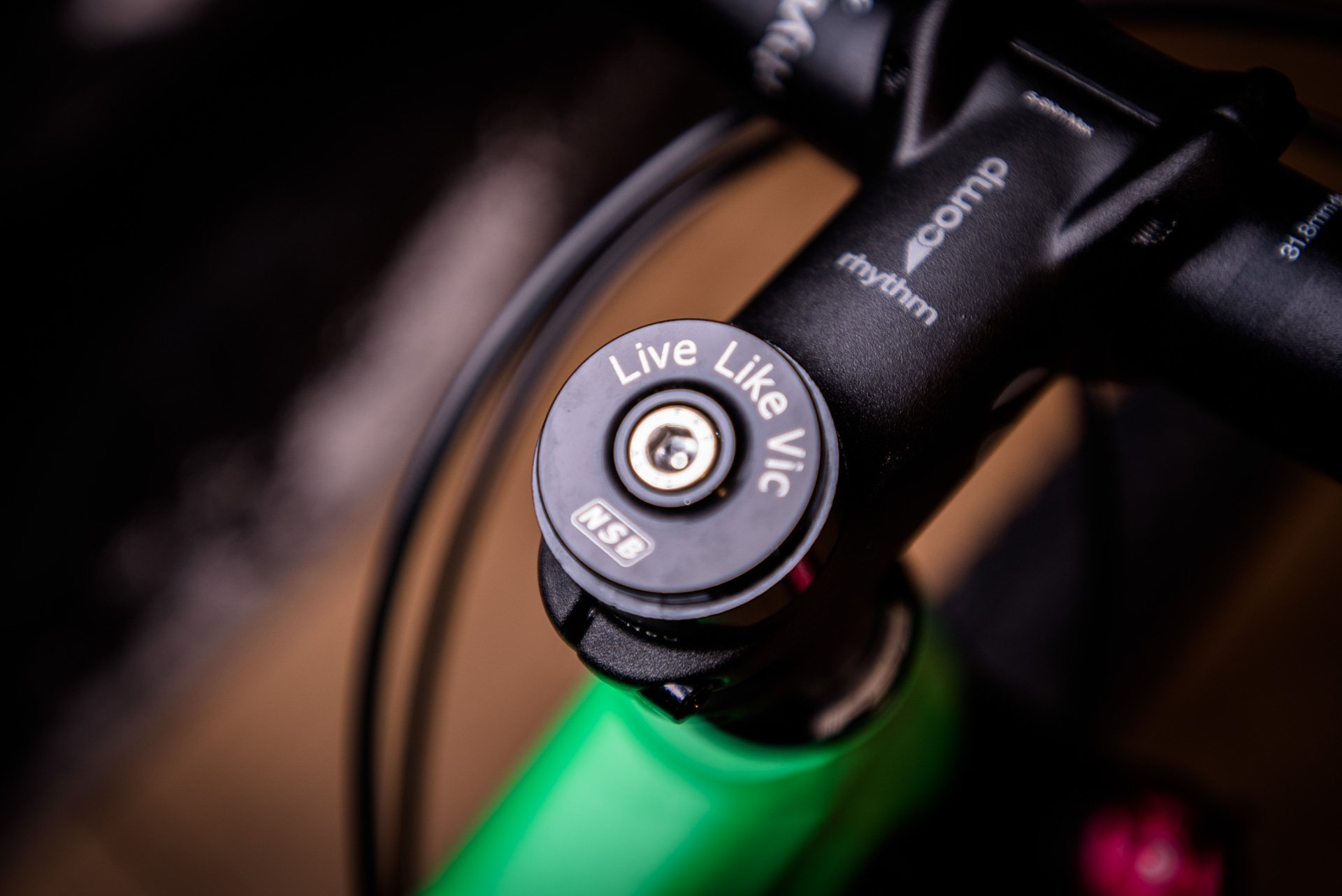
Live Like Vic: Dig, Ride, Repeat
With an 18.5" frame size chosen based on reach and top tube length, I can just barely run a 125mm X-Fusion Manic post without the stealth mechanism bottoming out inside the frame. The X-Fusion has a relatively low minimum height thanks to the low profile seal head and clamp so those with shorter legs than my 32" inseam will likely want to look at a 100mm post. Another alternative is to go with the external version of Fox's Transfer post which has a fixed cable but ditches the actuator reducing its overall length.
Stache Hits
The Stache 7's green paint job is Bright Green. Sure, colour choice is 100% personal preference but like the bike, the colour is anything but boring. Actually, if anything I think Trek missed an opportunity to have SUNringle fully colour match the Duroc 50 SL rims. Can you say green SUN Doublewides circa Freeride?
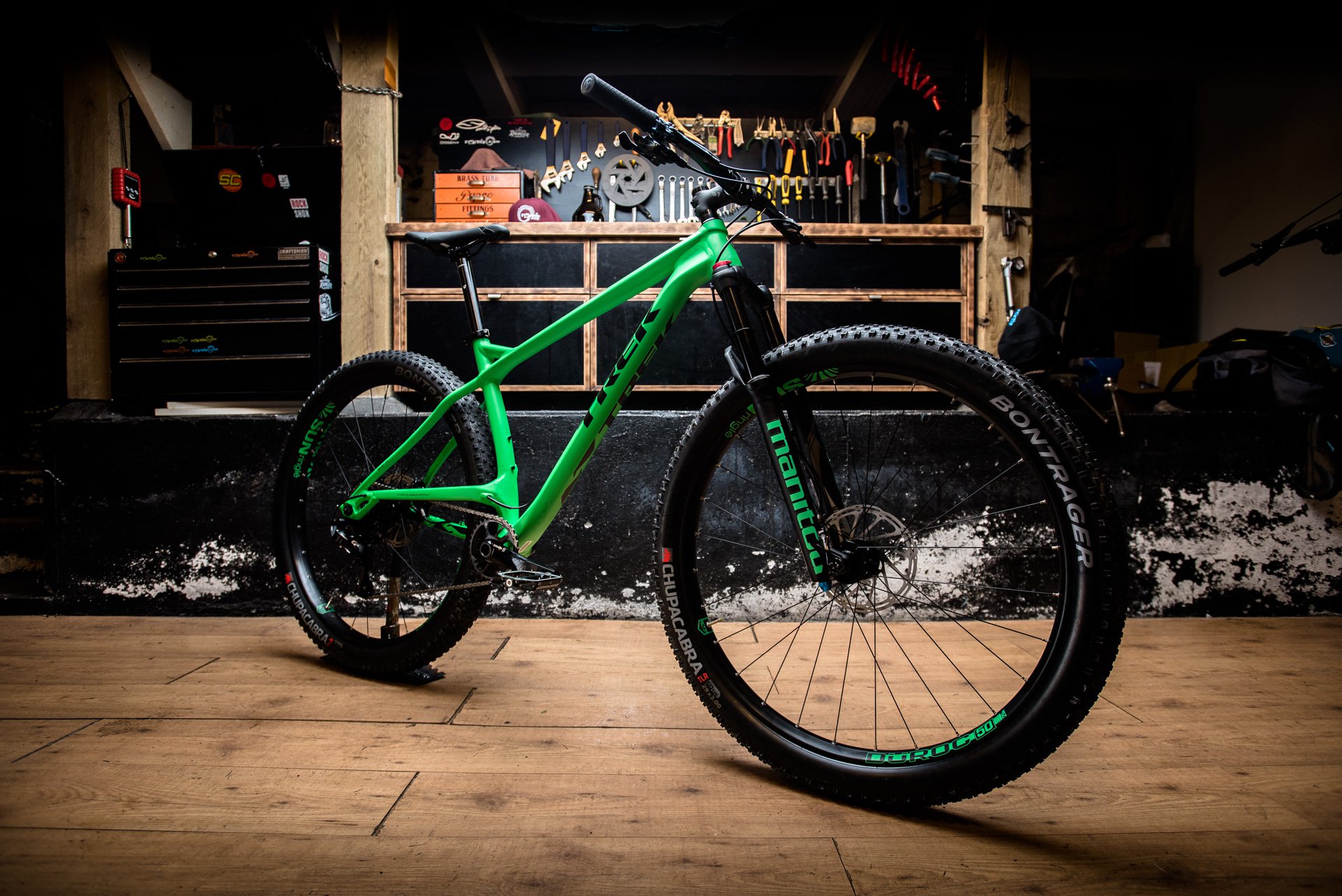
The Manitou fork and SUNringle Duroc rims tie in nicely with the Stache 7's mean green paint scheme. I do wish Trek had gone all the way and had the rims painted to match.
I would prefer geometry that would feature a slacker head tube angle but this is unapologetically an anywhere-and-everywhere trail bike with a static 68.4°.
The Manitou Magnum 34 Comp fork feels good out of the box and offers a stiff chassis.
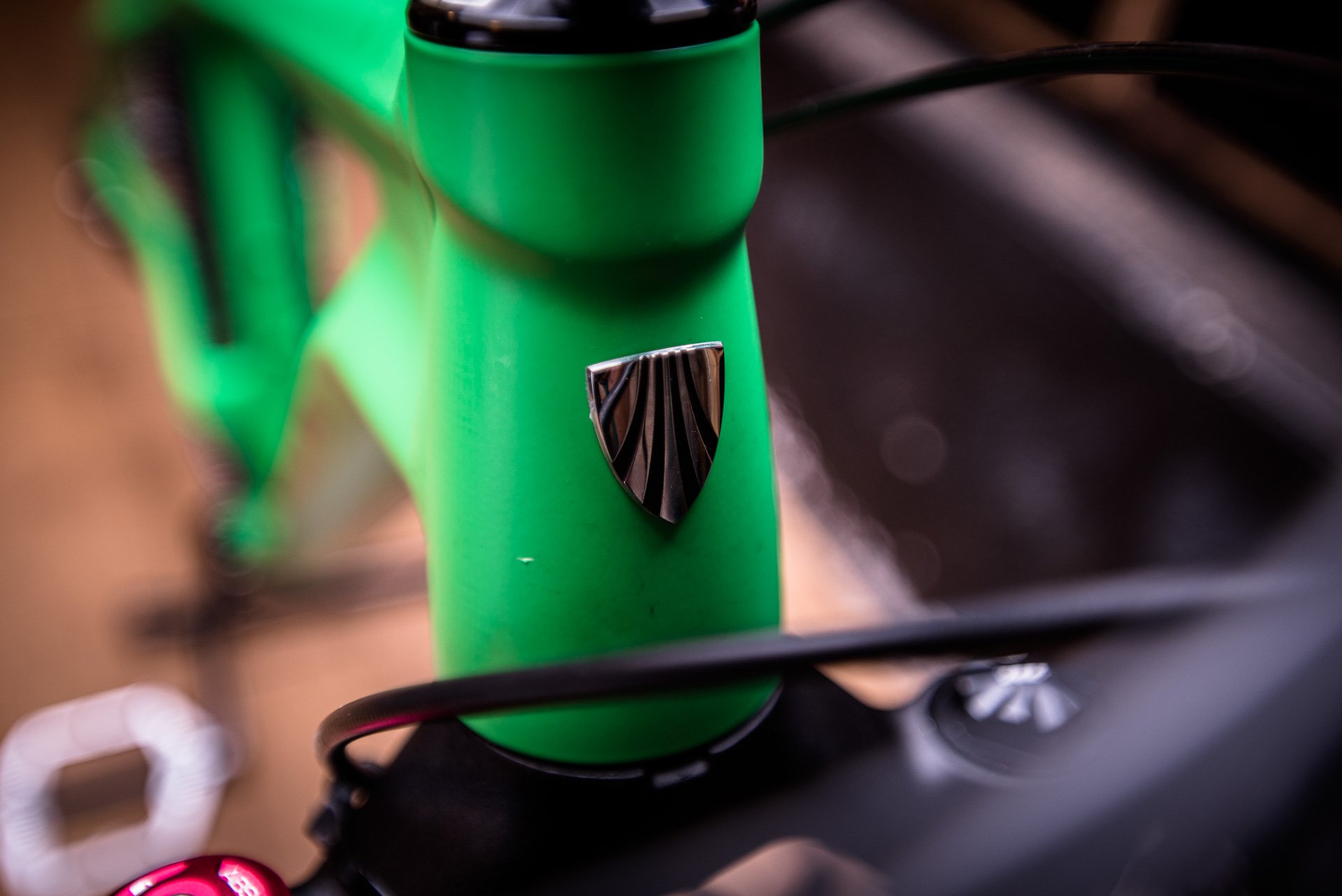
I wish Trek had left the brake line on the front brake a touch longer because this is, in my opinion, the cleanest way to run a brake line with the Reverse Arch and it was tight to make it work. #cableporn
I think the 30t chainring is a good match for the bike's 30lbs weight, big wheels, giant-ish rubber and 10-42 cassette. Some riders might prefer a 28t or a 36t ring but most will likely be satisfied with the 30t until it wears out.
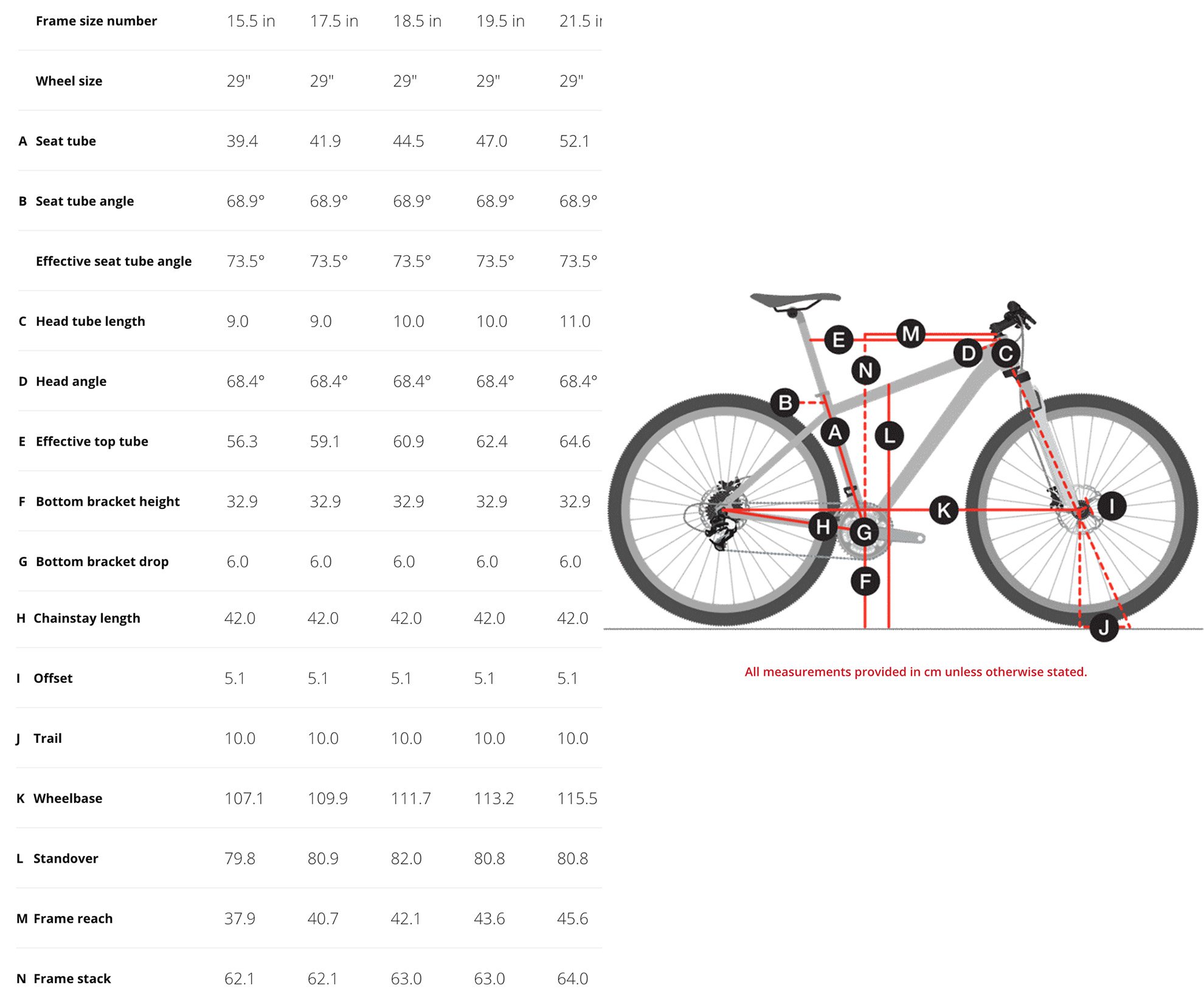
Stache Misses
The Stache has an actual seat tube angle of 68.9 and a claimed effective angle of 73.5 which offers a great pedaling position while not approaching the bleeding edge. Where I'm at a loss is why they've included a 1 cm offset seat post. Most riders prefer a steeper STA than I do so if I have the seat centered on the stock post I can imagine most customers will prefer a post with no offset, and would likely buy a dropper post with no offset for this frame.

Trek gets wide bars - they even make a few 820mm options under their Bontrager brand name. I'd like to see one stock on the Stache 7 so that riders can cut them down to their preferred length instead of having to buy a new bar at the time of purchase.
How cliché is this? I'm going to jump right in as the obligatory reviewer complaining about a narrow stock handlebar. It's not that Trek doesn't get wide handlebars - they manufacture multiple 820mm Bontrager options in carbon and aluminum including an 820mm version of the Rythm Elite on the Stache.
I can't ride an 820mm bar personally but I can cut it down to my preferred 780mm width instead of ditching the 750mm stock option and having to dump money into a cockpit upgrade on a brand new bike. Trek makes two larger sizes of the Stache and I doubt many dudes looking for a 456mm Reach | 646mm Top Tube are going to be happy thrashing this aggressive 29+ hardtail with the stock cockpit. It's a cheap and relatively easy upgrade but it's money that could be put towards a dropper post, Maxxis DHF 3c front tire, pedals and etc.
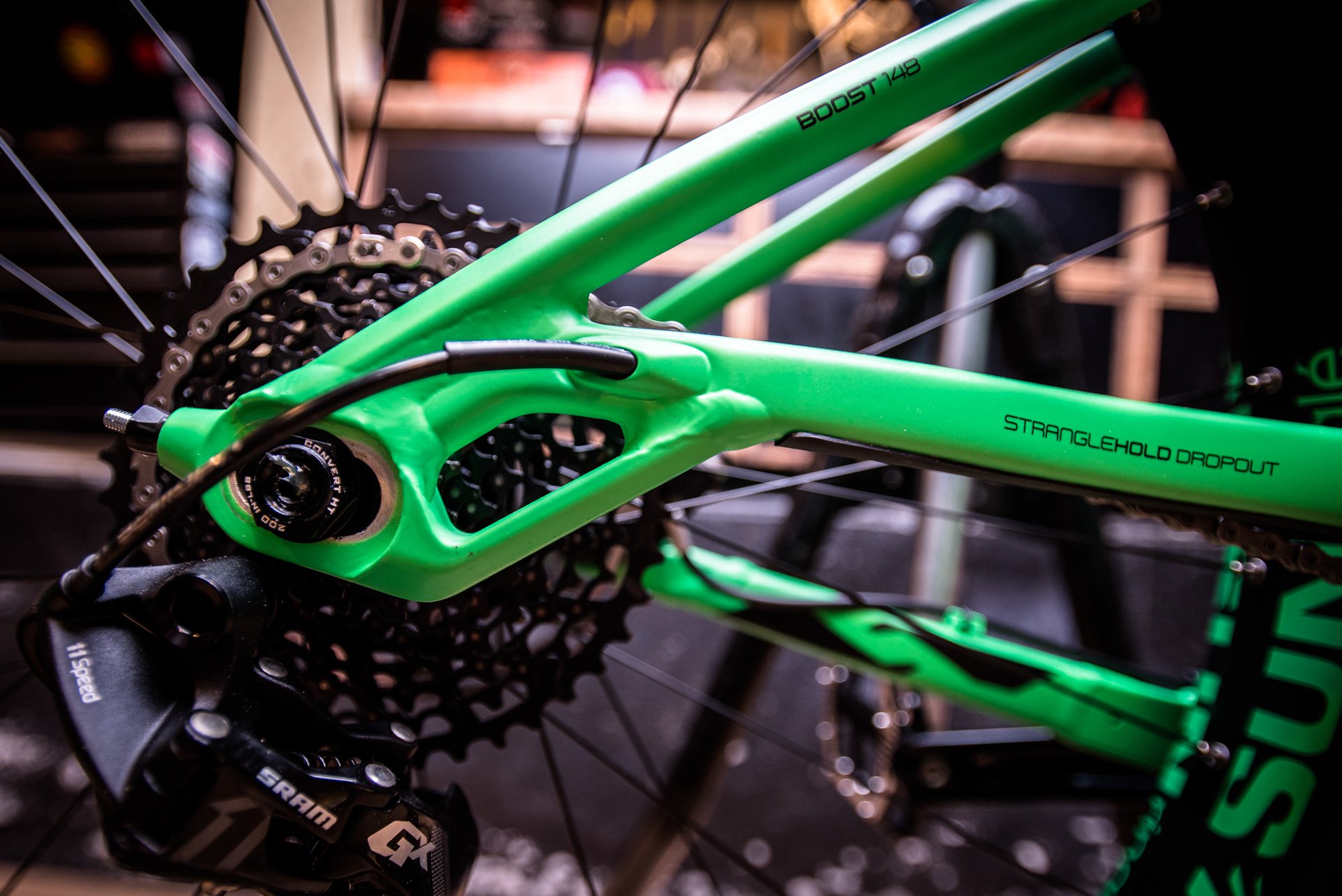
Really sweet dropouts. Adapt the bike for 27+, 29 or 29+. Tension the chain and run it single speed!
Must Stache Rides?
I'm looking forward to exploring the Stache's capabilities. It looks to be capable of taking multiple wheel and tire sizes and easily set-up single speed. I'm betting it can survive in some pretty aggressive terrain thanks to its huge wheels, neutral geo and ample travel up front.
Like any bike that straddles categories, there is probably no such thing as a perfect ride for the Stache but I'm absolutely happy to be proven wrong. Worst case scenario, for someone without a massive stable of bikes I think the highly unique Stache will handle diverse duties at a reasonable price.
For more on the Trek Stache click here...
*Yes, I will be single speeding this bike as part of the test period. Check out those dropouts!
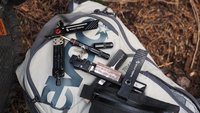

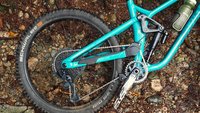
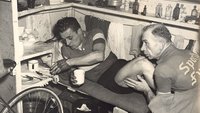
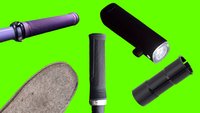

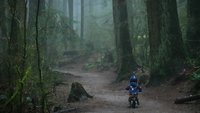
Comments
LWK
6 years, 9 months ago
looking forward to your ride review, a comparison of the 29+ vs the more common 27+ would be great as I have been curious about that. my regular rides are still 26 (HT and 160 FS) and I got a Stache 5 last fall.
for where I live, it is a fantastic wet weather, snow and winter bike. the tires worked really well in the type of mud we have (i.e., I can keep pedaling vs hardly being able to walk on my 26" bikes with minions). you can pad thru wet soft trails instead of digging trenches. once snow is packed down a bit and if not icy, I think its better than a fat bike. rolling resistance seems not much different from my other bikes.
I think its an excellent all round bike for beginner - intermediate rider or up to 2/3 - 3/4 speed for an expert. but after that I suspect you're better off on a smaller tired/wheeled bike. It is very sensitive to tire pressure and if a bit low any aggressive cornering is unnerving. the big tires offer goofy fun traction but they are slow to transition into and between corners. local terrain doesnt have rocks but I would be leery how long the tires would last riding sharp rocky terrain at speed (they have been surprisingly durable on the dirt, roots and gravel I ride on though). and the tires are $150/ea at retail to replace....
so I dont think this will replace your latest and greatest super-enduro sled but otherwise i think the last sentence in the article is likely a fair summary.
Reply
Andrew Major
6 years, 9 months ago
Thanks LWK,
Are you still running the Chupacabras or have you experimented with any other tires? I know they're big money but the DHF 3c 29x3" I've been riding has been wearing surprisingly well.
Rolling resistance with the Chupas is surprisingly little compared to the aggressive 29x2.3" tires on my regular 29'er but those are Shore winter tires and these are not (at least up front).
Cheers,
Reply
mrbrett
6 years, 9 months ago
I don't have experience on the Chupacabras on the test bike, rather some 29 x 3" Maxxis Chronicles that seem comparable. I did switch out the front to a 29 x 3" Minion DHF that does roll slower but offers a lot more confidence on wet trails. I think in the summer, Chronicle front and rear would be my go to - a Minion front (or rear too!) would be great in mushy seasons.
Reply
LWK
6 years, 9 months ago
I havent experimented. I tend to use things till they wear out and only replace if something really doesnt work. so still just running the Chupacabras! I agree the rolling resistance is very good. I honestly dont think its any worse then my 26" 2.35 DHF minions.
Reply
Andrew Major
6 years, 9 months ago
The 29x3" DHF 3c is an amazing tire up front. Really happy with mine on my personal bike.
Chupacabras are definitely fast for how much rubber is there though.
Reply
Cam McRae
6 years, 9 months ago
I have to admit to being curious about how this bike rides. My eyes have opened to other wheel and tire sizes this winter and I'd like to know if this rides like a monster truck or a light speeder. Has anyone else ridden one?
Reply
OscarN
6 years, 9 months ago
Regarding front brake hose routing, I route the front brake line between the crown and the arch on my Mattoc. Looks pretty clean and doesn't seem to get in the way or contact the stanchions.
Reply
Andrew Major
6 years, 9 months ago
I'm sure that is what Trek intended... it just doesn't work for me - and never has on reverse arch fork.
Reply
bdole
6 years, 9 months ago
I've put about 50 miles on one so far. It's plenty rowdy and climbs like a beast. When the tires are up to speed, you notice it resists changing direction a bit, due to all that rotating mass. The plus tires aren't a substitute for rear suspension, even shorter travel stuff. But I think if you don't want to spring for a full suspension bike, this definitely makes sense versus a more conventional hardtail. I'm also not that tall, about 5'6" and maybe the concept of a 29+ is a bit too large for my person.
Reply
WNCmotard
6 years, 9 months ago
To each their own I suppose. I'm 6'2" with a wide wingspan and all my bars were gradually cut down to 750, that's where I'm most comfortable.
I recently picked up a Stache 5, did a few upgrades and have it setup as a single speed and love it. Decent wheels and going tubeless dropped over 2lbs of rotating mass. And there's only 300gr of difference between it and my regular 29er wheel / tire combo. For what I wanted it for, it's perfect. For riding burlier stuff I have a FS 29er.
Reply
Andrew Major
6 years, 9 months ago
Exactly... to each their own: spec'ing the 820 bar we could all be happy and it's way cheaper/easier to hacksaw the ends off than to replace.
How do you like it compare to running a regular 29er SS? Definitely planning to single speed as part of the test.
Reply
WNCmotard
6 years, 9 months ago
That's a very valid point Andrew, you can always take some off, but can never put some back on.
Well, for me at least, I greatly prefer it to standard sized tires. That being said, I am a bigger guy at 190lbs sans gear, so that may play into it somewhat. Single speeding to me is a lot like 125cc motocross, it's all about conservation of momentum, and anything you can do to help that will generally yield positive results. The amount of traction on tap means I can carry more speed through corners, and other places I'd be slower on a standard tire. It also means I've cleaned climbs I haven't made on any other SS, especially loose over hardpack or leaf / pine straw littered trails. The big tires and wheels do have more of a gyro effect, so you may work a little harder on quick side to side transitions. But that same thing helps you maintain momentum like crazy. I can't count the number of times I've had to ride the brakes coasting to keep from hitting my buddies in front of me on regular 29er single speeds. The plus tires take the edge of the aluminum frame also. BUT, a good low pressure gauge is key, 1/2lb is a noticeable difference in how the bike rides.
I've read reports that the elevated stay on the Stache in SS mode suffers from some flexxing that will result in chain skipping and popping on smaller rear cogs BTW. I'm running an AB 30t oval, with either a 20t or 21t rear cog and a Shimano HG40 chain, and haven't had any issues.
Reply
Mike Chivy
4 years, 6 months ago
For the life of my I cant figure out if I need an offset if I want to change the chainstay. Is this boost? How can I tell. All I want to do is go from 30T to 32T and have no idea if I need an offset or not. Please help!
Reply
Please log in to leave a comment.